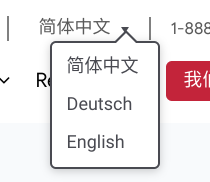Introducing the HubSpot Content Hub! Discover how HubSpot Content Hub's AI tools, personalization features & more can help you excel in content marketing.
Raggiungere un pubblico globale costruendo un sito web multilingue
Espandete la vostra visibilità online e raggiungete un pubblico più vasto creando un sito web multilingue. Scoprite come HubSpot può aiutarvi a tradurre efficacemente i vostri contenuti e a ottimizzarli per il SEO multilingue.

Comprendere l'importanza di un sito web multilingue
Nel mondo interconnesso di oggi, avere un sito web multilingue è fondamentale per le aziende che vogliono raggiungere un pubblico globale. Offrendo i vostri contenuti di marketing in più lingue, potete comunicare efficacemente con i clienti di tutto il mondo e creare un'esperienza più personalizzata. Questo non solo contribuisce ad aumentare la visibilità del vostro sito web, ma migliora anche la soddisfazione e la fiducia dei clienti.
Inoltre, un sito multilingue vi consente di accedere a nuovi mercati e di ampliare la vostra base di clienti. Si aprono opportunità di partnership internazionali, collaborazioni e crescita del business a livello globale. Parlando la lingua dei vostri clienti, potete abbattere le barriere e stabilire legami più forti con loro, migliorando il riconoscimento e la fedeltà al marchio.
Con la crescente globalizzazione dei mercati, avere un sito web multilingue è diventato un vantaggio competitivo. Dimostra che date valore alla diversità e siete disposti a soddisfare le esigenze di culture e lingue diverse. Questo può darvi un vantaggio sui vostri concorrenti e posizionare la vostra azienda come un attore globale nel vostro settore.
In generale, comprendere l'importanza di un sito web multilingue è fondamentale per qualsiasi azienda che voglia espandere la propria presenza online e connettersi con un pubblico globale. Investendo nella traduzione e nella localizzazione, è possibile raggiungere efficacemente clienti di paesi e culture diverse, migliorare l'esperienza dell'utente, creare fiducia e favorire la crescita del business.
Scegliere la giusta strategia di traduzione
Quando si costruisce un sito web multilingue, la scelta della giusta strategia di traduzione è fondamentale per lo sviluppo dei contenuti e della navigazione del sito. Si possono adottare diversi approcci a seconda del budget, delle risorse e del pubblico di riferimento.
-
Un'opzione è quella di assumere traduttori professionisti, servizi di traduzione o creatori di contenuti che siano madrelingua delle lingue di destinazione. Questo garantisce traduzioni accurate e di alta qualità che colgono le sfumature e il contesto culturale dei contenuti. Tuttavia, questa soluzione può essere costosa e richiedere molto tempo, soprattutto se la mole di contenuti da tradurre è elevata.
-
Un'altra opzione è l'utilizzo di strumenti di traduzione automatica come Google Translate o Microsoft Translator. Sebbene questi strumenti siano migliorati nel corso degli anni, hanno ancora dei limiti per quanto riguarda l'accuratezza e il contesto, e scoprirete che le traduzioni automatiche non sempre hanno senso. È essenziale rivedere e modificare attentamente i contenuti tradotti automaticamente per garantire la qualità.
Sebbene HubSpot non traduca automaticamente i contenuti del vostro sito web, attualmente HubSpot si integra con più di 16 applicazioni con
tra quelle più diffuse.
HubSpot dispone di diverse funzioni sofisticate per supportare siti multilingue, commutatori di lingua e supporto SEO.
In definitiva, la giusta strategia di traduzione dipende dalle vostre esigenze e dai vostri obiettivi specifici. State fornendo tutti i vostri servizi in tutte le lingue? La lingua supportata è quella del progetto o solo quella del sito web? I servizi sono ugualmente cruciali nei mercati di destinazione?
È importante considerare fattori quali il budget, la qualità, i vincoli di tempo e le preferenze del pubblico target. Scegliendo la strategia giusta, potrete tradurre efficacemente i vostri contenuti e offrire un'esperienza multilingue senza soluzione di continuità ai visitatori del vostro sito web.
You might also like:
Migliori pratiche per i siti web multilingue
-
Prima di tradurre tutto ciò che è presente sul vostro sito web in più lingue, ottimizzate il vostro sito web per una sola lingua, ad esempio con contenuti validi per ogni fase del percorso dell'acquirente, ottimizzati per la SEO e la conversione.
-
A meno che non abbiate un budget illimitato (o un piccolo sito web) per tradurre l'intero sito in una o più lingue, pensate a un'espansione graduale. In una modalità di progettazione orientata alla crescita, questo significa creare pagine essenziali come la homepage, la pagina Chi siamo e la pagina Contatti.
Esempio: Al momento della pubblicazione di questo articolo, Aspiration Marketing sta espandendo la creazione di contenuti in inglese, francese, tedesco, mandarino e spagnolo. Solo per le pagine disponibili in altre lingue, il modulo HubSpot language switcher offre la versione in altra lingua nel menu a tendina language switcher:

-
Dare priorità alle pagine da tradurre che hanno già avuto un grande successo nella lingua originale, i post del blog più visitati, i post del blog più influenti, le landing page a più alta conversione, ecc. Questo presuppone che siano rilevanti anche nella lingua tradotta. Una pagina sul successo di YouTube o del marketing su Facebook sarà poco rilevante nella Cina continentale.....
Sfruttare HubSpot per creare un sito web multilingue
HubSpot offre strumenti e funzioni potenti per aiutarvi a creare e gestire un sito web multilingue. Con HubSpot Content Hub (il sistema di gestione dei contenuti di HubSpot), è possibile creare e organizzare facilmente contenuti in più lingue, rendendoli più accessibili al pubblico di riferimento.
Inoltre, il CMS di HubSpot offre strumenti di ottimizzazione SEO che consentono di ottimizzare il sito web multilingue per i motori di ricerca. È possibile personalizzare facilmente le pagine web, i meta tag, gli URL e altri elementi SEO per ogni lingua, assicurando che il vostro sito sia ben posizionato in mercati e lingue diverse.
Utilizzando HubSpot per la creazione di siti web multilingue, è possibile semplificare il processo di traduzione, garantire la coerenza della traduzione e ottimizzare il sito web per la SEO globale. In questo modo potete risparmiare tempo e risorse e massimizzare l'impatto del vostro sito web multilingue.
Ottimizzazione del sito web multilingue per la SEO
L'ottimizzazione del vostro sito web multilingue per la SEO è fondamentale per garantirne la visibilità e la portata in mercati e lingue diverse. Ecco alcuni consigli per ottimizzare efficacemente il vostro sito web per i motori di ricerca:
-
Condurre una ricerca sulle parole chiave: Identificate le parole chiave pertinenti in ciascuna lingua di destinazione da includere nei contenuti, nei meta tag e negli URL. Utilizzate gli strumenti di ricerca delle parole chiave per determinare il volume di ricerca e la concorrenza.
-
Localizzare i contenuti: Traducete i contenuti in modo da tenere conto delle differenze culturali e delle preferenze locali. Questo include l'adattamento del messaggio, delle immagini e del design in modo che risuonino con il pubblico di destinazione in ogni lingua.
-
Personalizzare meta tag e URL: Ottimizzate i meta tag, le meta descrizioni e gli URL per ogni lingua. Includete parole chiave pertinenti e assicuratevi che descrivano accuratamente il contenuto di ogni pagina.
-
Implementare i tag hreflang: I tag hreflang aiutano i motori di ricerca a capire la lingua di destinazione delle pagine web. Implementate questi tag per indicare la lingua e il Paese di destinazione di ciascuna pagina.
-
Creare backlink: Ottenete backlink di alta qualità da siti web affidabili in ciascuna lingua di destinazione. Questo può migliorare l'autorità e la visibilità del vostro sito web nei risultati dei motori di ricerca.
-
Monitorare e analizzare: Monitorate regolarmente le prestazioni del vostro sito web nelle diverse lingue utilizzando strumenti di analisi SEO. Tracciate le classifiche, il traffico organico e i tassi di conversione per identificare le aree di miglioramento.
Seguendo questi consigli per l'ottimizzazione SEO, potrete migliorare la visibilità e la portata del vostro sito web multilingue, attirando più traffico organico ed espandendo il vostro pubblico globale.
Potrebbe piacerti anche:
Come utilizziamo HubSpot Content Hub per la SEO
Scoprite come utilizziamo HubSpot Content Hub per la SEO, aumentare il traffico organico e ottimizzare i nostri contenuti per il successo.
Misurare il successo del vostro sito web multilingue
Misurare il successo del vostro sito web multilingue è essenziale per comprenderne l'impatto e prendere decisioni basate sui dati per migliorarlo. Ecco alcune metriche chiave da considerare:
- Traffico del sito web: Monitorate il traffico complessivo del vostro sito web multilingue e seguite le prestazioni di ciascuna lingua. Analizzate le fonti di traffico e identificate eventuali variazioni o tendenze.
- Tassi di conversione: Misurare i tassi di conversione per ogni lingua per valutare l'efficacia dei contenuti multilingue. Confrontate i tassi di conversione tra le varie lingue e ottimizzate di conseguenza.
- Coinvolgimento degli utenti: Analizzate le metriche di coinvolgimento degli utenti, come la frequenza di rimbalzo, il tempo di permanenza sulla pagina e le pagine per sessione. In questo modo è possibile capire come i visitatori interagiscono con il vostro sito web multilingue e individuare le aree di miglioramento.
- Prestazioni SEO: Tracciate le classifiche e il traffico organico per ogni lingua per valutare l'efficacia dei vostri sforzi SEO. Identificate le parole chiave che hanno un buon rendimento e ottimizzatele per altre parole chiave, se necessario.
- Feedback dei clienti: Raccogliete i feedback dei visitatori del vostro sito web multilingue attraverso sondaggi, moduli di feedback o social media. Questo può fornire preziose indicazioni sulla loro esperienza e aiutare a identificare le aree di miglioramento.
Monitorando e analizzando regolarmente queste metriche, potete misurare il successo del vostro sito web multilingue e identificare le opportunità di ottimizzazione. Questo approccio basato sui dati vi aiuterà a migliorare continuamente le prestazioni del vostro sito web e a servire meglio il vostro pubblico globale.
Domande frequenti sui siti web multilingue
Non esiste un unico approccio “più efficace” alla traduzione di siti web, poiché il metodo migliore dipende da vari fattori quali budget, pubblico di destinazione, dimensioni del sito web e complessità dei contenuti. Di seguito è riportata una panoramica dei diversi approcci con i relativi pro e contro principali:
1. Traduzione automatica:
- Pro: Opzioni veloci, convenienti e facilmente disponibili come Google Translate o CharGPT.
- Contro: Spesso manca di accuratezza e sfumature e fatica con l'umorismo, i modi di dire e i riferimenti culturali.
2. Traduzione umana:
- Pro: Traduzioni di alta qualità, accurate e culturalmente appropriate.
- Contro: costoso, richiede tempo, è necessario trovare traduttori qualificati che abbiano familiarità con il mercato di destinazione.
3. Approccio ibrido:
- Pro: Combina convenienza e qualità. Utilizza la traduzione automatica per la traduzione iniziale, quindi affidala a un revisore umano che la modifichi e la perfezioni.
- Svantaggi: richiede ancora l'intervento umano, con un aumento dei costi rispetto alla traduzione automatica pura.
Questo contenuto è disponibile in:
- Tedesco: Globale Präsenz mit einer mehrsprachigen Website
- Inglese: Reach a Global Audience by Building a Multilingual Website
- Spagnolo: Llegue a Una Audiencia Global Creando un Sitio Web Multilingüe
- Francese: Atteignez un public mondial en créant un site Web multilingue
- Rumeno: Atingeți o audiență globală prin crearea unui site web multilingv
- Cinese: 通过多语言网站吸引全球受众

Joachim, formatore certificato HubSpot con oltre 13 anni di esperienza in Content Marketing, Strategia, implementazione di siti web e SEO, ha realizzato numerosi progetti di growth marketing internazionali su larga scala, ad esempio con UiPath, dallo status di startup fino alla quotazione in borsa (IPO) al NYSE. Joachim ha una competenza particolare in progetti multilingua di Marketing e Sales Enablement, sfruttando per i nostri clienti le più avanzate tecnologie di intelligenza artificiale (IA).








.webp?width=352&name=Blog_WBM_Platforms%20for%20Engaging%20Your%20Audience%20(1).webp)
Facci sapere cosa ne pensi.